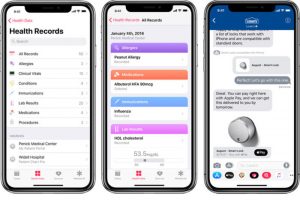Nuance Communications explained the huge potential of Apple’s Business Chat platform, which one day means we’ll be able to ask our HomePod to arrange our next bank loan.
While we wait for Apple to eradicate the Siri message-reading bug inside iOS 11.3, Nuance Communications took a little time to explain the huge potential of the iPhone maker’s Business Chat platform, which one day means we’ll be able to ask our HomePod to arrange our next bank loan. Robert Weideman, executive vice president and general manager of the Nuance Enterprise Division, explained why.
What’s the connection between Apple and Nuance?
Nuance Communications and Apple have worked together for some time. They worked together on the original implementation of Siri and have worked together once again on Apple’s Business Chat platform.
Nuance has an extensive presence in messaging and voice services. You’re already using solutions supported by Nuance within certain branded messaging-based interactions; company’s such as JetStar, Delta Airlines, USAA, and FedEx use Nuance.
The company recently published research that shows over 55 percent of consumers prefer to use a form of messaging to communicate with companies.
That stat confirms Apple’s decision to deploy Business Chat within Messages is something we are all growing to need. Messages is one of the most popular messaging tools in use worldwide, Weideman explained….
“It gives brands a huge opportunity to engage with consumers in an innovative way – allowing them to ask questions about products and services, or make a purchase using Apple Pay all through personalized and intelligent dialog. That’s powerful,” he said.
Engagement of Things
The company notes that interest in messaging is growing rapidly.
The idea that platforms give way to services and that voice replaces other forms of user interaction with computing systems has particular implications in the future of wearable devices.
“We have customers globally who see this channel as the future and the technology has evolved so that messaging really can become the connective tissue between engagement channels,” Weideman told me. “We expect it to continue to proliferate as a key means of communicating.”
At the same time, users don’t want to find advertising and democracy-destroying behavior hacks following them around as they use solutions like these, which is where (I think) Apple’s principled stance on privacyputs its solutions head and shoulders above those on offer from every other smart device maker in the industry.
“We see a future where conversational AI combined with intelligent engagement allows consumers to engage from whatever end-point they choose whether that’s a mobile phone, TV or smart speaker, and brands immediately know what’s needed and can predict what to do next,” Weideman said.
More than simple questions
The kinds of tasks these solutions will be able to handle will extend over time.
“We call this the ‘Engagement of Things’ where a single brain not only provides transactional answers – ‘Hey Alexa, play my favorite songs’ – but where people can engage to get more complex things done – ‘Pay my Visa bill next Tuesday, with $500 from my checking account, and send me a confirmation.’ And over time – ‘I had an accident. I need to file a claim [which will need a police report, statement, copy of this/that and take days to get all the info],” Weideman said.
You won’t just be asking Siri to play songs or for the temperature; you’ll soon be asking it to conduct much more complex tasks, such as arranging loans and paying bills.
Enterprise communications
The potential for enterprises to use messaging for customer engagement is huge. Weideman described a few ways in which such technologies could be deployed:
- For proactive notifications
- Two-way SMS, as widely used for credit card fraud alerts, gate/flight changes, prescriptions refills, and appointment reminders
- To work within messaging apps, such as WeChat and Facebook Messenger
“Messaging can also be used as part of the voice channel strategy,” he explained. “For example, if a consumer calls in by phone, brands can offer consumers the opportunity to have their conversation automatically moved to digital messaging vs. waiting on hold. This has been successful because customer prefer it to waiting, and it allows enterprises to automate via a virtual assistant, and if needed escalated to human agents who can serve more customers at the same time vs. a phone call.”
Et tu, HomePod?
Of course, the addition of Siri support within Messages and Business Chat means you’ll be able to use a HomePod or AirPod system to engage in these communications, Weideman suggests.
“Growing channels like smart speakers and IoT devices are also important,” he said. As consumers get used to using smart speakers to get weather data or information about their commute, they will grow to expect to be able to “engage with their telcos, banks, and healthcare providers that same way.”
In theory, at least, you’ll be able to resolve various kinds of problems with service providers using natural language via your HomePod, Apple Watch, or even some Beats and AirPod earphones — all thanks to Business Chat.
Enterprise users must think about …
Enterprise users will need to spend a little time thinking about how they want to make themselves available using these technologies.
In line with the modern recommendation of the importance of omnichannel marketing to every business, Nuance recommends they support all available channels.
“Customers want the same experience across all channels — whatever they engage via messaging, on the web, on Facebook or wherever. Nuance enables enterprises to do this with Design Once, Deploy Many approach — where the work to design and implement the conversational and engagement ‘AI brain’ is the same for all channels, combining self-service (VA) with Assisted-Service [human assist, live messaging/chat, voice, video],” Weideman said.
The human touch
“We are already delivering the future, where conversational AI and intelligent engagement is combined with human intelligence, enabling brands to better (and more affordably) engage with their customers, through any channel depending on their preference,” Weideman added.
Nuance stressed that AI-based solutions like Business Chat are not enough in isolation. “AI alone will fail when it comes to customer service,” they said.
The company’s favored approach is to combine conversational AI within a broader strategy that also includes human intelligence, not just for accuracy but to deliver the best experience.
“In cases of an angry customer or someone with a complex or emotional request, there is a need for the human touch,” Weideman added, warning that brands must find a way to retain contextual understanding while making effective sense of the huge volume of information they must be prepared to expect will come to them once they put Business Chat systems in place.
However, the direction of travel is pretty clear: If you can text it, you can speak it. And in the future, we’ll see a growing number of tasks that we can transact using combined technologies such as AirPods, Business Chat and voice assistants like Siri.
Updated March 29 with Robert Weideman’s full job title.


